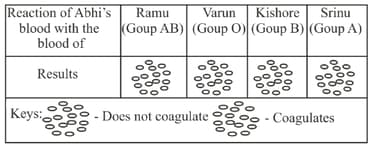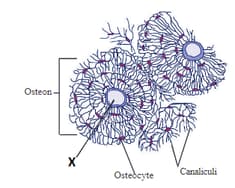Animal Tissues
Animal Tissues: Overview
This Topic covers sub-topics such as Bone, Blood, Eosinophils, Lymphocytes, Platelets, Bone Marrow, Ligaments, Neurons, Neutrophils, Plasma, Connective Tissues, Cartilage, Epithelial Tissues, Monocytes, Tendons, Basophils, Muscle Tissue and, Nervous Tissue
Important Questions on Animal Tissues
Figure shows the result of mixing Abhi's blood with Ramu's, Varun's, Kishore's and Srinu's blood. What is Abhi's blood group?

Write about striated, unstriated and cardiac muscles with diagrams.
Explain the different types of epithelial tissue with their location and function.
Eosinophils are a type of disease-fighting white blood cell.
There are various types of tissues. A is one of them, which is involved in producing force and generating motion, either for locomotion or for other body movements within internal organs. There are three types of tissue A:
X: they are typically attached to bones.
Y: found in the heart.
Z: they are found in the inner walls of organs.
Tissue A is associated with different movements including walking, running, lifting, chewing, picking and dropping objects, etc. There are other major functions of tissue A in the body like maintaining an erect position, or posture and controls respiration by automatically driving the movement of air both into and out of the body.
Identify the type of tissue 'Y' and 'Z'.
There are various types of tissues. A is one of them, which is involved in producing force and generating motion, either for locomotion or for other body movements within internal organs. There are three types of tissue A:
X: they are typically attached to bones.
Y: found in the heart.
Z: they are found in the inner walls of organs.
Tissues A are associated with different movements including walking, running, lifting, chewing, picking and dropping objects, etc. There are other major functions of A tissue in the body like maintaining an erect position, or posture and controls respiration by automatically driving the movement of air both into and out of the body.
Name the protein which tissue A contains.
There are various types of tissues. A is one of them, which is involved in producing force and generating motion, either for locomotion or for other body movements within internal organs. There are three types of tissue A:
X: they are typically attached to bones.
Y: found in the heart.
Z: they are found in the inner walls of organs.
Tissues A are associated with different movements including walking, running, lifting, chewing, picking and dropping objects, etc. There are other major functions of A tissue in the body like maintaining an erect position, or posture and controls respiration by automatically driving the movement of air both into and out of the body.
Identify the type of tissue 'X'.
There are various types of tissues. A is one of them, which is involved in producing force and generating motion, either for locomotion or for other body movements within internal organs. There are three types of tissue A:
X: they are typically attached to bones.
Y: found in the heart.
Z: they are found in the inner walls of organs.
Tissues A are associated with different movements including walking, running, lifting, chewing, picking and dropping objects, etc. There are other major functions of A tissue in the body like maintaining an erect position, or posture and controls respiration by automatically driving the movement of air both into and out of the body.
Identify the type of tissue A.
The given diagram shows the bone cells.

Identify the part labelled as 'X'.
Macrophages synthesise and secrete collagen proteins.
